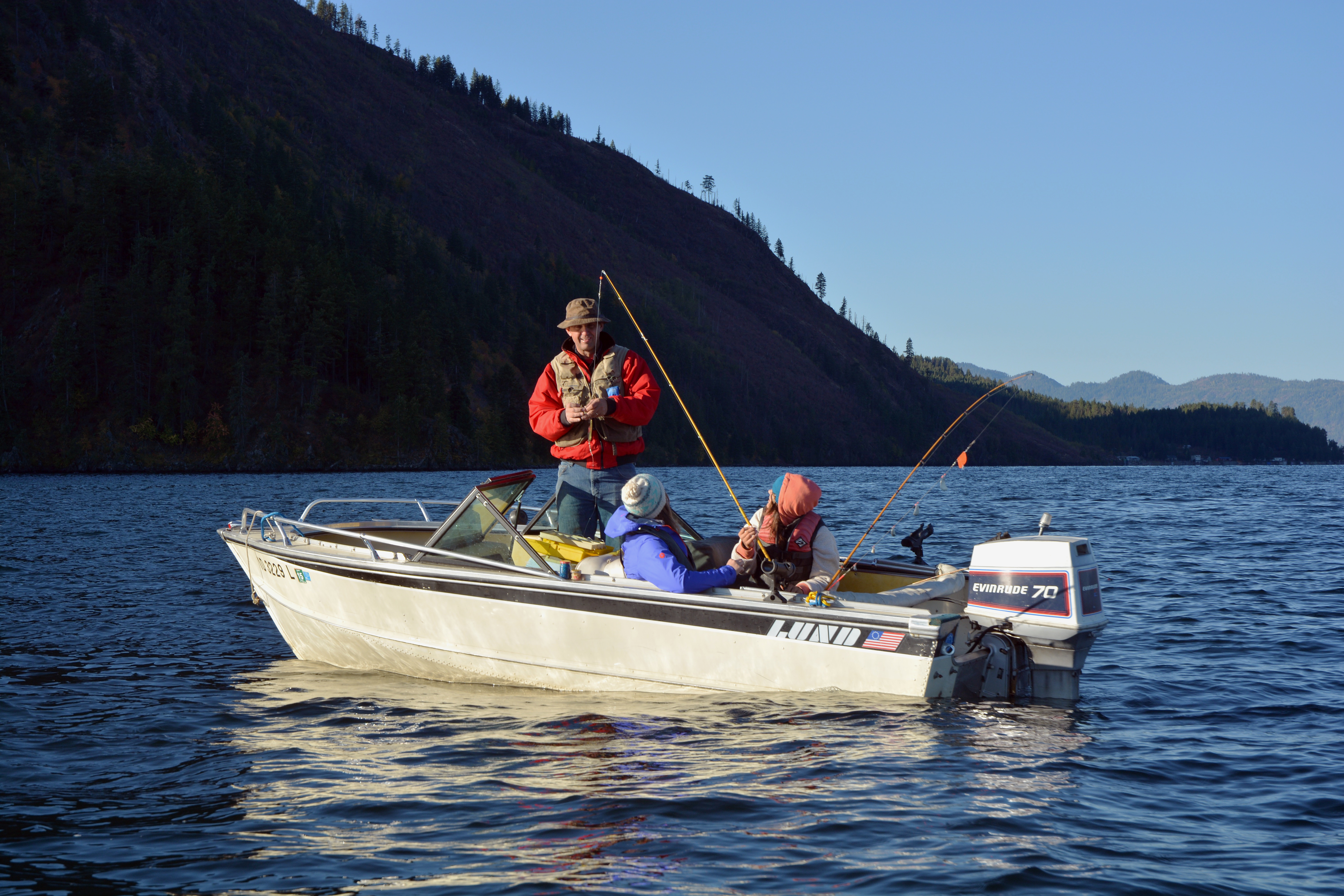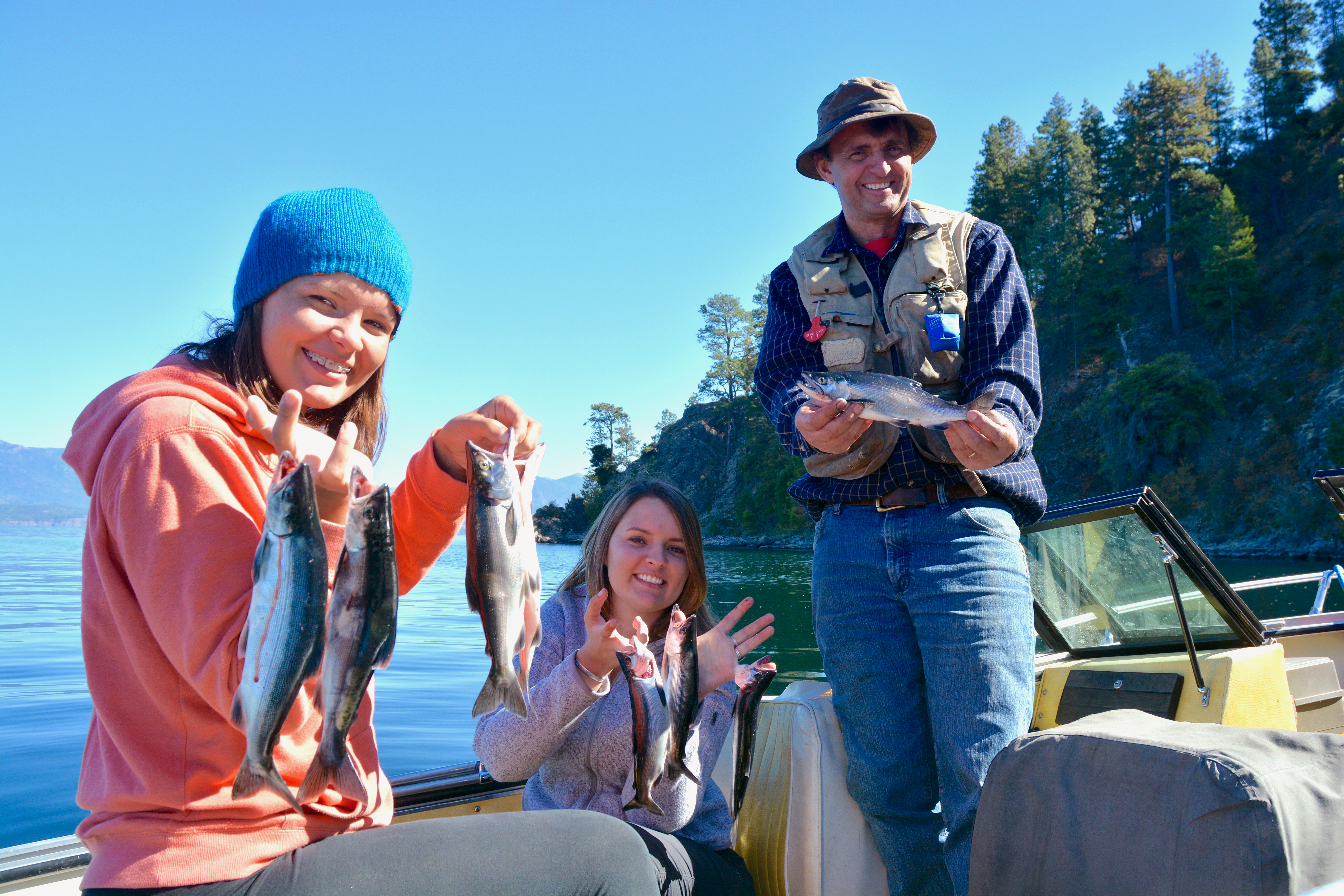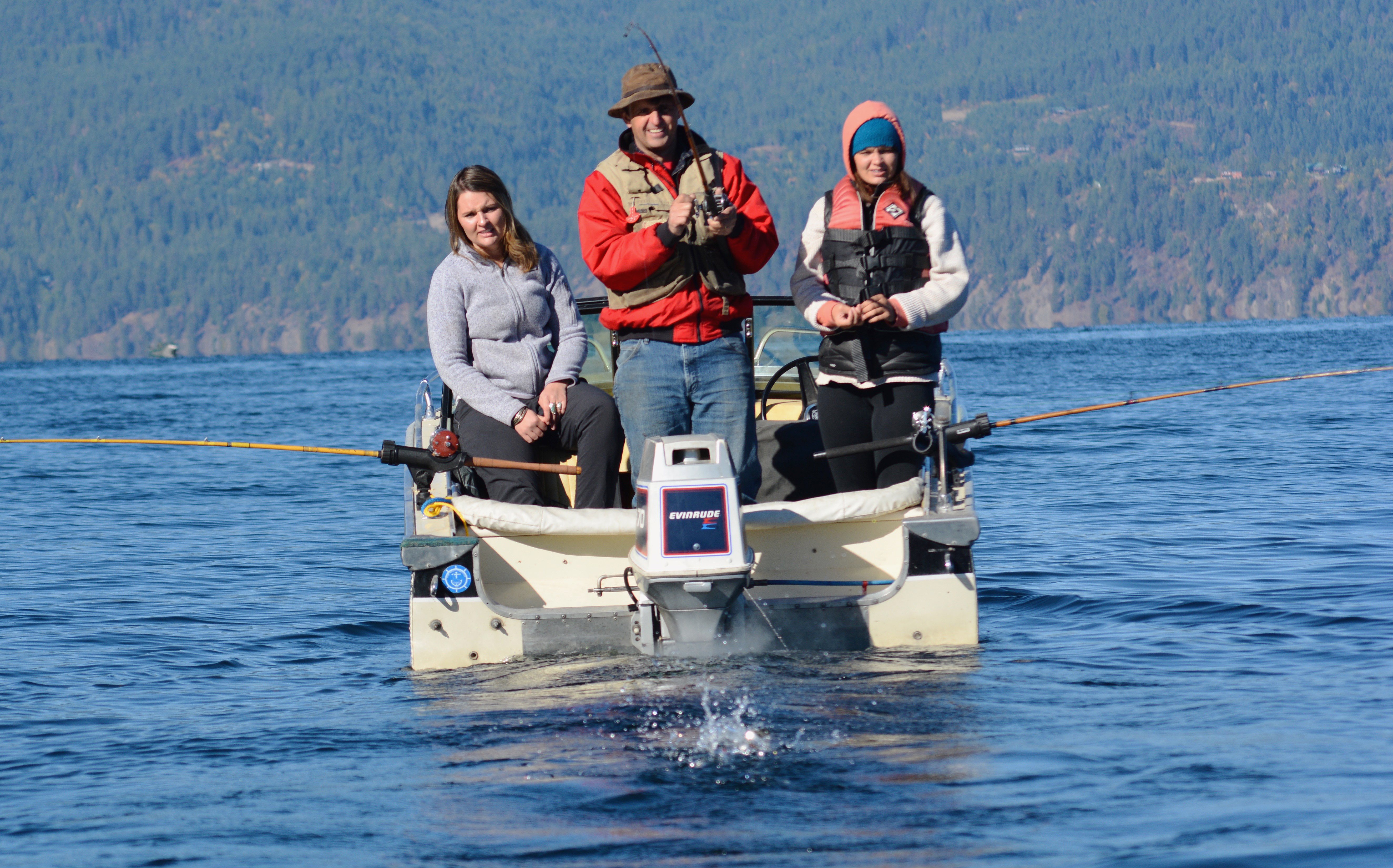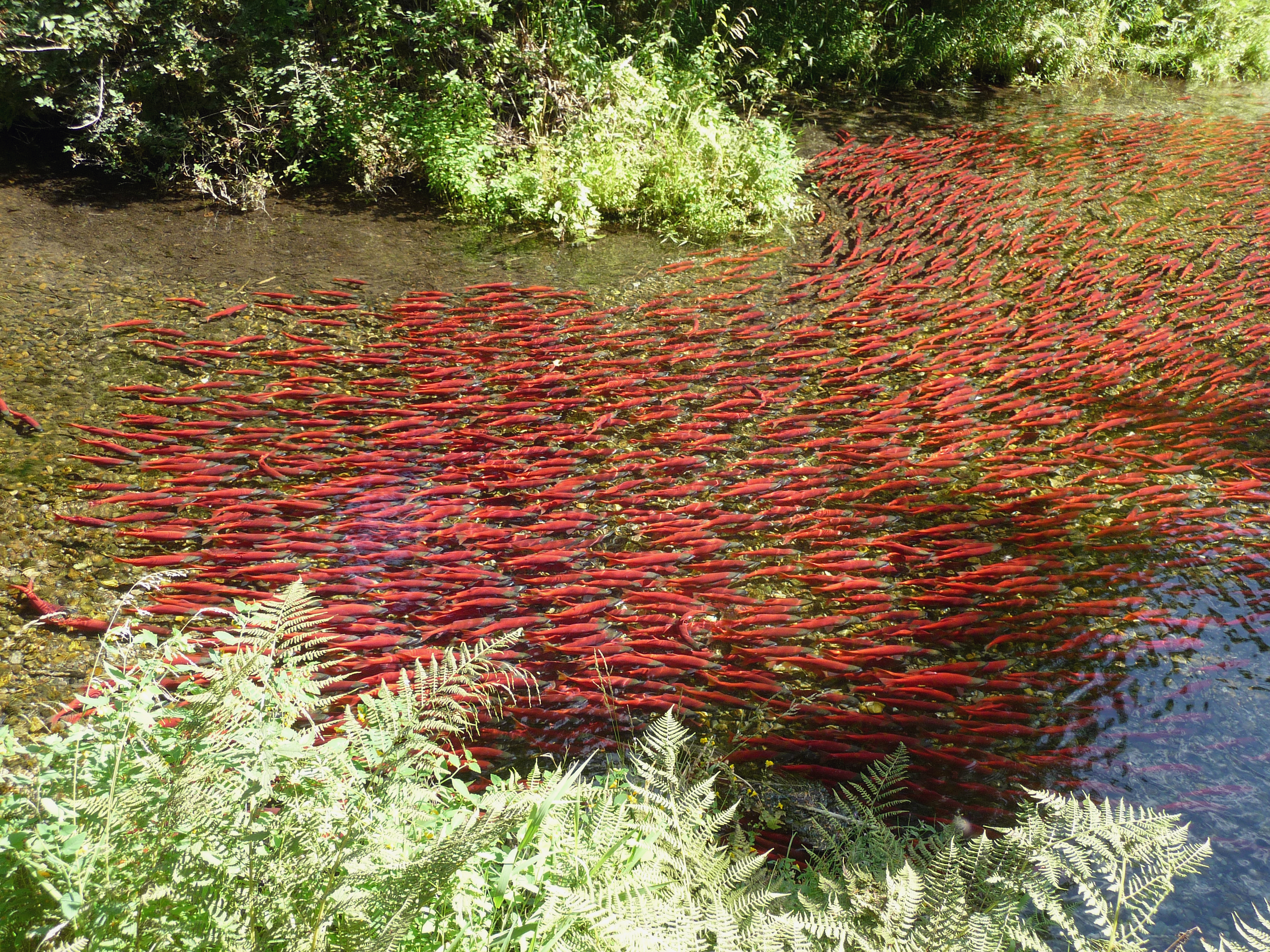Kokanee rebound in Lake Pend Oreille
By Roger Phillips, Idaho Fish and Game Public Information Specialist, October 2016
Idaho’s biggest lake presented Idaho Fish and Game with one of its biggest fisheries challenges. How do you manage diverse fish populations in a lake that covers 134 square miles? How do you target a certain fish species in a lake so deep it is used to test submarines? How do you eliminate a bunch of big fish and replace them with small ones, and make anglers happy about it? Add to the mix an endangered species, a tiny crustacean and a world-class fishery at stake, and you have a management challenge akin to tight-rope walking on roller skates.
“This was an aggressive management program, to say the least,”
—Jim Fredericks, Fisheries Chief
Idaho Fish and Game took on that challenge in the early 2000s at North Idaho’s Lake Pend Oreille when it was on the brink of losing its prized kokanee. The fisheries restoration project seems to be working; kokanee salmon numbers have rebounded and anglers have returned to catch them. About 100,000 spawners recently flooded Fish and Game’s Granite Creek fish trap in the northeast corner of lake, ensuring a future generation of kokanee.
At the same time, the lake’s prized rainbow trout – which includes the current state record and former world’s record – are increasing in size and numbers, and lucky anglers are catching lunkers that top 20 pounds.
“This was an aggressive management program, to say the least,” Fish and Game’s Fisheries Bureau Chief Jim Fredericks said. “We had a lot confidence, but the fact is the project was an experiment on a scale that hasn’t been done before in Idaho.”
That doesn’t mean Fish and Game has declared victory and all parties are completely satisfied with the results, but it showed Fish and Game can achieve a compromise between competing interests by reducing a fish population to boost others and maintaining balance in Idaho’s largest and deepest lake.
A carousel of introduced fish
Bull trout and cutthroat trout are native to Lake Pend Oreille, but they now share the lake with a suite of non-native species, including kokanee, rainbow trout, lake trout, brown trout, smallmouth bass, walleye, yellow perch, black crappie and others.
Kokanee arrived during the 1930s from Flathead Lake, Mont., presumably during a 1933 flood. Kokanee populations quickly established and became one of the most popular fisheries in the state, supporting both sport and commercial fishing.
The lake is also known for its trophy trout. It produced the current world’s-record bull trout, a 32-pounder in 1949, and a previous world-record, 37-pound rainbow trout in 1947 that remains the state record.
With millions of kokanee, trophy trout and a variety of other species for anglers, Lake Pend Oreille has a rich history.
Bill Hawkins’ ancestors homesteaded on the shores of Lake Pend Oreille in 1881 and the family is now in its seventh generation there. Hawkins, 49, remembers hundreds of small boats fishing for kokanee. His uncle, Ben, caught kokanee and whitefish commercially during the Great Depression, and the tradition of fishing for kokanee and whitefish continues with his sons and daughters.
“It’s always been a special place,” Hawkins said. “That’s our fun, coming out on the lake and catching fish.”
Like an underwater whodunnit
Kokanee numbers declined through the 80s and 90s, prompting a series of research projects. Initially, biologists suspected Mysis, a small shrimp introduced in the 1960s to provide fish food, may have actually competed with kokanee for the lake’s plankton. Lake levels and spawning habitat were also identified as potential problems and studied.
Then, in the mid 2000s, kokanee populations crashed. Surveys done by dragging a fine-meshed net through the lake showed there were reasonable numbers of young kokanee, but their numbers plunged when the fish reached about two years old, and there were barely enough spawners to replenish the population. At that point, it was clear that predators posed the greatest, most immediate threat.
Lake Trout were introduced into Lake Pend Oreille in 1925, but their numbers remained low and manageable until the late 1990s when they started flourishing and causing problems. Research showed that along with rainbow trout and bull trout, lake trout were aggressive kokanee predators.
To complicate matters for Fish and Game, rainbows and lake trout have ardent and vocal supporters, which is understandable. Who doesn’t like trout the size of salmon?
“Anglers saw a system that looked like it had the best of all worlds,” Fredericks said.
Fish and Game biologists were mostly concerned about lake trout. Part of the reason was those tiny shrimp, which provide reliable food for young lake trout until the lakers grew big enough to switch to kokanee as their favored meal.
Lake Pend Oreille’s trophy trout were popular and valued by the angling community. After mostly harvesting its large rainbows for decades, anglers started releasing them during the 1980s and 1990s.
“It was basically a meat fishery up to that point,” Hawkins said.
Anglers took pride in their conservation of those trophy rainbows, but combined with a growing lake trout population, there were too many big fish eating kokanee. Populations dropped so low kokanee fishing closed to anglers in Lake Pend Oreille in 2000, and lots of the lake’s anglers stayed home.
“You’d come out on the lake in 2002, and you wouldn’t see another boat fishing. It was just dead,” he said.
Too much of a “good” thing
Lake trout aren’t “bad” fish. Fish and Game manages nearby Priest Lake for its lake trout fishing, which also holds the state record, a 57-pound monster caught in 1971. But fisheries managers know there are trade-offs when it comes to managing populations.
Even in a lake the size of Pend Oreille, resources are limited. Through intensive population surveys and research, Fish and Game biologists correlated the explosion of lake trout populations in the late 1990s with the decline of kokanee.
The adult kokanee population had dropped from about 3 million in 1993 to less than 50,000 in 2002-03. Fish and Game and anglers faced a difficult choice: drastically reduce Pend Oreille’s lake trout population, or risk the complete loss of kokanee, which would be followed by losing bull trout and trophy rainbow trout.
Fish and Game officials knew they couldn’t just impose an aggressive management program to curtail lake trout populations, so it formed a citizen’s advisory panel to help them decide on a course of action.
They also enlisted Dr. Mike Hansen, a fisheries professor with University of Wisconsin-Stevens Point, who has extensive experience with lake trout management in the Great Lakes.
Enter the “Judas” trout
At the encouragement of the citizen’s panel, Fish and Game took a two-pronged approach to reduce Lake Pend Oreille’s lake trout population. Fish and Game enlisted sport anglers, and gave them a $15 bounty on each lake trout and large rainbow they harvested. The department also hired a commercial fishing crew out of the Great Lakes to catch lake trout with nets.
Many anglers criticized the netting program and felt they could remove lake trout if provided an incentive. Their expertise and local knowledge made them effective at harvesting lake trout, and Avista funded a bounty program for anglers to be rewarded for removing large trout from the lake.
Chip Corsi, Fish and Game’s Panhandle Region Supervisor, said Dr. Hansen’s work showed that additional lake trout removal through netting was necessary to improve the odds of success.
“Ultimately, I believe the key to getting angler buy-in on a scale that was meaningful was making them a part of the solution with the bounty, and also by continuous public involvement through the stakeholder group, and regular outreach to all anglers,” he said.
Commercial netters faced their own challenges. The netting operations cost about $500,000 annually and were paid for by Avista and the Bonneville Power Administration. Netters had to catch large enough quantities to justify the cost of their operation.
In 2006-07, anglers caught about three lake trout for every one that was netted. By 2010, the netters had identified lake trout nursery areas, which greatly increased their catch. They also got help from Fish and Game’s biologists and “Judas” lake trout.
Beginning in 2007, biologists caught adult lake trout and implanted telemetry devices in them before releasing them so they could monitor the fishes’ movements. They knew lake trout congregated in certain areas during spawning season, but they didn’t know exactly where, or how many spawning areas were in the lake.
To their surprise, the tagged fish concentrated in two spawning areas about 15 miles apart, and several of the fish consistently migrated between the two.
Those Judas fish gave away secrets the netters needed. After catching fewer fish than anglers from 2006-08, netters more than doubled the anglers’ catches in 2009-10, and landed more lake trout than anglers every year after.
Since 2006, anglers and netters removed a whopping 177,000 lake trout from Lake Pend Oreille with anglers accounting for 79,000 of those and netters taking 98,000.
“We demonstrated that you can get over a hump to the point of impacting recruitment and driving the lake trout population down,” Fredericks said.
The head vs. the heart
While biology and math could predict what was needed to restore kokanee and the lake’s prized fishery, neither deadened the sting of anglers seeing thousands of prized lake and rainbow trout being killed.
To ease the pain, the netted lake trout were taken to food banks, and anglers got money for killing rainbows, but the prescription was still bitter medicine.
“It created huge heartburn in the community,” Hawkins said.
To add to their gut wrenching, there were no guarantees the kokanee population would respond, or if they did, how long it would take to see results, or be able to catch kokanee again.
Hawkins said he had other suspicions about the project.
“I honestly thought Fish and Game had ulterior motives and wanted bull trout recovery, and we wouldn’t be able to fish the lake again,” he said.
Bad fishing equals good news
Lake trout removal topped out in 2010 with 26,000 fish taken by anglers and netters, and totals steadily declined through 2014 to about 13,000 fish. Anglers’ share topped out in 2007 at about 18,000 fish, then dropped to just 2,500 by 2014.
After nine years of intensive harvest, all signs pointed to a drastically smaller lake trout population. Monitoring showed adult and juvenile lake trout were reduced by over 80 percent since the program began in 2006.
“The vast majority of what are getting caught now is the little guys about 6 to 12 inches, and we’re getting fewer of those,” Fredericks said.
In 2001, the year after kokanee angling ended on Lake Pend Oreille, biologists estimated there were fewer than 200,000 adult kokanee in the lake. Adult populations bounced around in the early and mid 2000s, and bottomed out in 2007 at an estimated 10,000 fish, the year after Fish and Game started aggressively removing lake trout.
Kokanee are nearly opposite of lake trout in terms of size and longevity. While lakers grow large and can live longer than 40 years, kokanee are relatively small and short-lived. Most adult kokanee range from 8 to 14 inches, and the land-locked salmon share their ocean-going cousin’s life cycle of spawning and dying at about three or four years of age.
But kokanee’s short life cycle can work in their favor. A female kokanee can produce 250 to 400 eggs, depending on her size. Fish and Game hatcheries put a good population of young fish into the lake each year, but the hurdle was helping them survive to adults.
Lake trout must grow about 20 inches before they become effective predators on kokanee, and with laker population knocked back, kokanee numbers steadily ramped up. In 2013, Fish and Game reopened kokanee fishing with a six-fish limit.
Skeptics feared that allowing anglers to catch and keep kokanee would erase those hard-earned gains, but the resilient fish proved otherwise. The adult population grew seven out of the nine years from 2006 through 2014, and it reached 1 million in 2013, which hadn’t happened in 17 years.
That allowed Fish and Game in 2014 to increase Lake Pend Oreille’s kokanee limit to 15 per day, where it remains. Kokanee anglers have returned to the lake in droves and had good success.
“I credit Fish and Game for staying the course,” Hawkins said. “I really thought we would never see a kokanee fishery again. Now we have a 15-fish limit, and these fish are phenomenal.
“I think bringing the kokanee back has brought significant interest to the lake, and that’s a good thing,” he added. “We’re such a tourist community, any of those dollars help.”
Bull trout have also benefited from having fewer lake trout to compete with, which has been an important step in their conservation.






